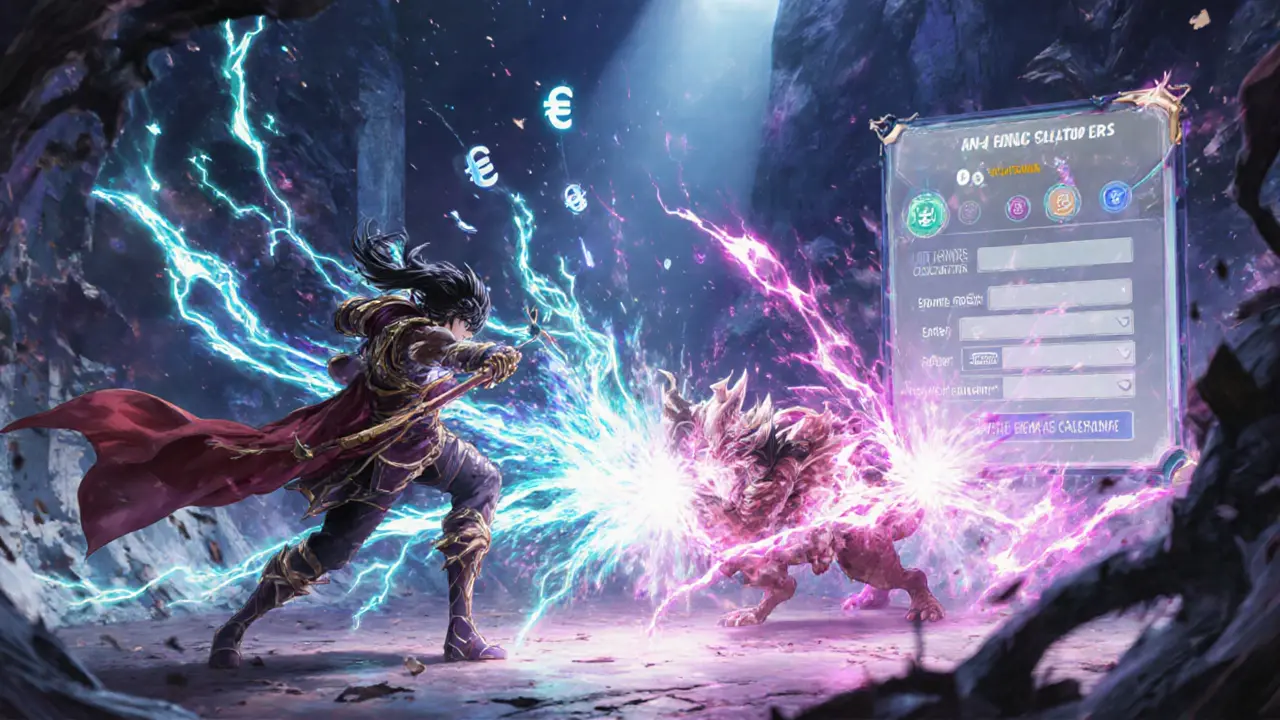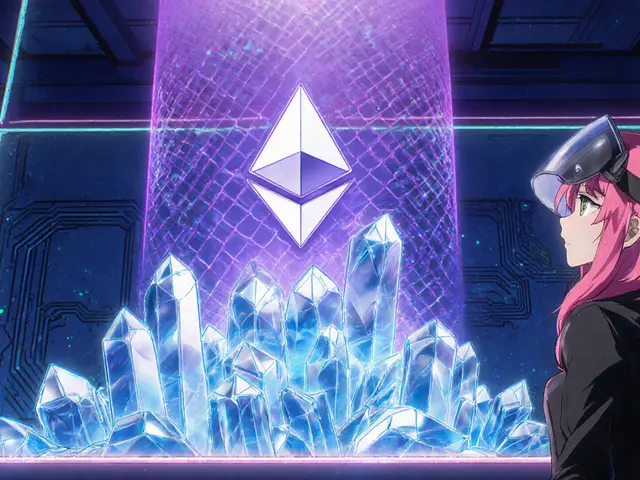Capverse Earnings Calculator
Estimate your potential CAP token earnings based on gameplay activities.
- Capverse (CAP) is a GameFi token on BNB Smart Chain using a play‑to‑earn pet‑battling model.
- Token supply data is inconsistent, and price swings of 70%+ are common.
- Liquidity lives mainly on MEXC Global; trading volume is under $300K daily.
- Compared to giants like Axie Infinity, Capverse is a micro‑cap project with limited adoption.
- Investors should watch supply transparency, exchange access, and community growth.
What is Capverse?
Capverse is a gaming‑focused cryptocurrency launched in 2023 that runs on the BNB Smart Chain using the BEP20 token standard. The project blends blockchain tech with a digital‑pet game set in an intergalactic universe. Players raise, battle, and trade virtual creatures while earning CAP tokens through both "play‑to‑earn" and "invite‑to‑earn" mechanisms.
Technical Foundations
The token lives on BNB Smart Chain - a high‑throughput blockchain that offers lower gas fees than Ethereum, making micro‑transactions viable for gaming. CAP follows the BEP20 token standard, which defines how tokens are transferred and interacted with on the chain. This choice keeps transaction costs under a few cents, but it also ties the project's accessibility to the Binance ecosystem and limits cross‑chain interoperability.
Gameplay Mechanics
Within the Capverse universe, users collect "digital pets" that can be summoned as "Sumers" - special creatures that boost battle performance. The core loops are:
- Pet raising: Feed, train, and evolve creatures to improve stats.
- Pet battles: Compete against other players in arena‑style fights; winning grants CAP rewards.
- Invite‑to‑earn: Share a referral link; both inviter and invitee earn a token bonus when the new player starts playing.
All in‑game assets (pets, skins, Summoners) are minted as NFTs, allowing owners to trade them on the built‑in marketplace. This creates a secondary revenue stream where rare NFTs can be sold for CAP or other BEP20 tokens.
Tokenomics & Supply Details
Public data on CAP's supply is fragmented. Some trackers list a total supply of 200million with zero circulating tokens, while others report a 1billion maximum supply with a modest circulating portion. The discrepancy makes market‑cap calculations unreliable - some platforms show a $0 valuation, others quote roughly $120million.
Price volatility is extreme. As of 30Sept2025, the token trades between $0.1148 (MEXC) and $0.1567 (WEEX). In the last 24hours, gains of up to 74% have been recorded, followed by sharp corrections. Such swings are typical for low‑liquidity GameFi tokens.

Market Access & Liquidity
Trading is confined to a handful of venues. The primary market is MEXC Global - offering the CAP/USDT pair with daily volumes near $56K, representing virtually all of the token’s activity. A secondary, thin market exists on PancakeSwap v3, which contributes only a few dollars of volume per day.
Limited exchange listings constrain liquidity, meaning large orders can move the price dramatically. For investors, this translates into higher slippage and difficulty exiting positions without impacting market price.
How Capverse Stacks Up Against Bigger GameFi Tokens
| Metric | Capverse (CAP) | Axie Infinity (AXS) | The Sandbox (SAND) |
|---|---|---|---|
| Launch Year | 2023 | 2018 | 2020 |
| Blockchain | BNB Smart Chain (BEP20) | Ethereum (ERC‑20) | Ethereum (ERC‑20) |
| Market Cap (Sept2025) | ~$120M (est.) | ~$1.2B | ~$1.1B |
| Daily Volume | $200‑$300K | $30M+ | $25M+ |
| Active Players | ~10K (estimated) | ~2M | ~1.5M |
| Main Gameplay | Digital‑pet battles, Invite‑to‑earn | Axie breeding & battling | Metaverse land & creations |
The table highlights that Capverse operates on a much smaller scale. While Axie Infinity and The Sandbox have established ecosystems, deep liquidity, and active communities, Capverse is still in an early‑adoption phase.
Risks & Considerations
- Supply ambiguity: Conflicting reports on total and circulating supply raise transparency concerns.
- Liquidity constraints: Concentrated trading on a single exchange can cause price manipulation.
- Volatility: Token price can swing 70%+ within a day, which is unsuitable for risk‑averse investors.
- Community size: Limited presence on Reddit, Twitter, or Discord suggests weak network effects.
- Team opacity: No public roadmap or founder identities make long‑term viability uncertain.
Getting Started - A Simple Purchase Guide
- Create a BNB Smart Chain compatible wallet (e.g., MetaMask configured for BSC or Trust Wallet).
- Deposit BNB or USDT into the wallet.
- Visit MEXC Global and locate the CAP/USDT trading pair.
- Place a market order for the desired amount of CAP. Because volume is low, consider splitting large orders into smaller chunks.
- After the trade, add CAP as a custom token in your wallet using the contract address published on the official Capverse site.
Always double‑check the contract address and be wary of phishing links. Storing CAP in a non‑custodial wallet gives you full control over your assets.
Frequently Asked Questions
What blockchain does Capverse run on?
Capverse is built on the BNB Smart Chain and follows the BEP20 token standard, which offers low transaction fees suitable for frequent in‑game actions.
How can I earn CAP tokens without buying them?
Players earn CAP by battling digital pets, summoning Sumers, and referring new users through the invite‑to‑earn program. Rewards are distributed directly to the player’s wallet after each qualifying action.
Is the CAP supply fixed?
Public data is inconsistent. Some sources list a fixed total of 200million tokens, while others claim a 1billion maximum supply. No official audit has been released, so the exact circulating amount remains unclear.
Where can I trade CAP?
The primary market is MEXC Global, which handles almost all daily volume. A secondary, low‑liquidity pair exists on PancakeSwap v3.
How does Capverse compare to Axie Infinity?
Capverse is a micro‑cap project with a pet‑battling focus on BNB Smart Chain, whereas Axie Infinity is an established Ethereum‑based GameFi platform with millions of active users, higher liquidity, and a broader ecosystem.







Comments
Carl Robertson
October 1, 2025 AT 02:27 AMWell, this Capverse saga reads like a drama on steroids – hype, half‑baked tech, and a token that seems to exist solely to fuel its own gossip. The supply numbers are a maze, and the price swings make my head spin faster than a pet battle on turbo mode. If you asked me to bet on this, I'd need a crystal ball and a stiff drink.
Rajini N
October 7, 2025 AT 21:07 PMFor anyone trying to get a clear picture, the token runs on BNB Smart Chain, which keeps fees low – a plus for frequent in‑game actions. However, the total supply figures are inconsistent, so treat market‑cap numbers with caution. Stick to reputable exchanges like MEXC and double‑check the contract address before buying.
Oreoluwa Towoju
October 14, 2025 AT 15:47 PMLiquidity is thin; big trades will move the price.
Jason Brittin
October 21, 2025 AT 10:27 AMLooks like Capverse is trying to be the underdog hero of GameFi, but with that kind of volume, you might need a cape just to stay afloat. 😂🚀
Amie Wilensky
October 28, 2025 AT 05:07 AMAh, the classic tale of promise versus reality…; one could argue that the very act of chasing these fleeting gains is a modern odyssey, a quest for glory in a digital coliseum; yet, amid the fanfare, the underlying mechanics remain elusive, a veil that only the most diligent will ever lift.
Clint Barnett
November 3, 2025 AT 23:47 PMLet me unpack the whole situation for you, step by step, because there’s a lot to digest here. First, the platform’s choice of BNB Smart Chain is both a blessing and a curse; on one hand, transaction costs are practically negligible, which is essential for a play‑to‑earn model that spawns countless micro‑transactions. On the other hand, the ecosystem is heavily tethered to Binance, limiting exposure to broader DeFi cross‑chain opportunities. Second, the tokenomics are shrouded in ambiguity – you’ll find one explorer listing a total supply of 200 million, another claiming a ceiling of 1 billion, and yet another refusing to disclose any concrete numbers at all. This lack of transparency should set off alarm bells for any prudent investor. Third, the liquidity pool is essentially a single‑lane highway; MEXC handles almost all of the daily volume, which hovers around $200‑$300 k. Trying to off‑load a sizable position there is likely to cause price slippage that could dent your returns dramatically. Fourth, compare the active user base – estimates put Capverse at about ten thousand players, while heavyweight GameFi projects like Axie Infinity boast millions. That disparity translates not just to market depth but to community‑driven development, secondary markets for NFTs, and overall project resilience. Fifth, the reward structure – you earn CAP for battling pets and for referrals – sounds attractive, but the real numbers reveal that average daily earnings are modest unless you’re a power user with hundreds of battles and referrals each day. Finally, the broader market context cannot be ignored; the token’s price volatility is legendary, swinging 70 % or more in a single day, which makes it a poor fit for risk‑averse portfolios. In short, Capverse offers an intriguing concept, but the combination of opaque supply data, thin liquidity, limited community size, and extreme volatility makes it a high‑risk, high‑reward proposition at best.
Jacob Anderson
November 10, 2025 AT 18:27 PMWow, a fifteen‑sentence novel about a token that probably can’t even pay for a cup of coffee. Talk about over‑engineering a hype train.